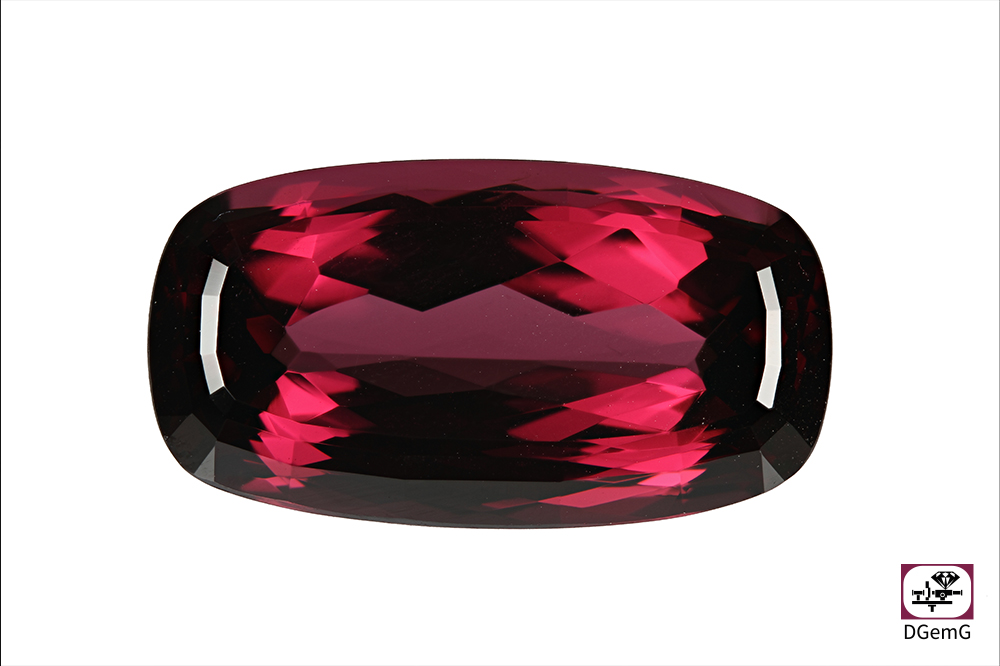The classic garnet is the red garnet, which has been used for jewellery purposes since ancient times (more information…). However, during the 20th century, several gemstones in the garnet group became popular, including rhodolite and mandarin garnet.
In 1898, the American mineralogist William Earl Hidden and J. H. Pratt discovered bright pinkish-red to pale violet garnets in Macon County, North Carolina, which they named rhodolite, after the Greek rhodon = rose, and lithos = stone. In English, these are sometimes also called “rose garnets”. Like red garnets, they are pyrope-almandine mixed crystals, but their colour has a distinct pink or rose component, and they are highly transparent.
The North Carolina deposits did not yield large quantities of the new garnet, which is why it was long time considered more of a collector’s stone in the jewellery trade. It wasn’t until the second half of the 20th century, that additional deposits were discovered, that produced garnets of comparable colour and transparency. Since the 1970ties, this has led to a sharp increase in the popularity of rhodolite (fig. 1) in the gem and jewellery trade. Its importance was further boosted by abundant finds in Tanzania (Ladaban and Kangala) and India (Naktamunda/Orissa). Additional deposits are found in Sri Lanka, Brazil, Madagascar, Mozambique and Malawi. The colour palette ranges from pinkish-red through reddish-pink to purple and reddish-violet, all the way to blue-violet. For several years now, Mozambique has also been supplying intensely purple, almost amethyst-coloured rhodolites, which are often referred to in the trade as “royal purple garnets”.
While classic red garnets often appear a bit too dark due to their high colour saturation, rhodolites impress with their high brilliance thanks to their lower colour saturation.
Some of the largest, fine rhodolites come from Tanzania, including faceted stones weighing over 80 carats. Some of the largest star rhodolites also come from Tanzania, some weighing over 15 carats. Exceptional pieces of jewellery with rhodolite have been sold at various auctions, including a diamond ring with rhodolites for US$ 10.000 and a necklace with diamonds and rhodolites for over € 28.000.
 Fig. 2 (left): A mandarin garnet crystal in the host rock. Image width approx. 10 cm, Photo: DGemG. Fig. 3 (right): A faceted mandarin garnet from Nigeria. Collection of DGemG, Photo: T. Stephan.
Fig. 2 (left): A mandarin garnet crystal in the host rock. Image width approx. 10 cm, Photo: DGemG. Fig. 3 (right): A faceted mandarin garnet from Nigeria. Collection of DGemG, Photo: T. Stephan.
Another speciality is orange spessartine, which has enjoyed great popularity since the discovery of an exceptional deposit in Namibia in 1992. It is known in the gem and jewellery trade as mandarin garnet.
Spessartine is a manganese-rich garnet that owes its name to a deposit in the Spessart Mountains in Germany. Such garnets were discovered there in 1797, but only gained importance among collectors.
Spessartine of gem quality was later discovered from a deposit in the USA, namely in Ramona County. Stones from this deposit exhibited some attractive orange colours, but due to limited production, demand on the international market was limited. Spessartine from other deposits, such as Brazil, exhibits less attractive orange-brown colours.
For these reasons, spessartine was relegated to a niche existence as a gemstone until the end of the 20th century.
The discoveries in northern Namibia fundamentally changed the situation. Along the Kunene River (Marien river), the border river with Angola, large crystals were found, some of them with an orange colour of extraordinary luminosity. A debate quickly erupted over the naming of these stones in the gem and jewellery industry. Mineralogically, they were known as spessartine, but this name was already being used for the less attractive orange-brown colours. An initial suggestion was “Hollandine”, after the Dutch royal family, but the international consensus was eventually on the term “Mandarin”.
Among the first discoveries is what is probably the largest faceted Namibian mandarin garnet, weighing 55.4 ct. This stone was examined and certified in 1994 in the laboratory of the DSEF German Gem Lab in Idar-Oberstein. However, the deposits in Namibia were largely exhausted by 1998, and continued mining was no longer profitable.
At about the same time (1999), bright orange garnets were discovered in Nigeria, supplying the industry with the now highly sought-after mandarin garnets. In general, faceted bright orange spessartine in good clarity from Namibia or Nigeria weighing over 5 ct are rare, and specimens over 10 ct are extremely rare. An exceptional large faceted mandarin garnet weighing 39.35 ct is housed in the Housten Museum of Natural Sciences.
In 2007, further discoveries were made in East Africa, specifically in the Loliondo region of northern Tanzania, and recently (2023) another deposit was discovered in the Longido region, also in Tanzania.
Faceted stones from Tanzania generally weigh less than 1 ct, although larger stones are occasionally known. Material of lower clarity that can be processed into cabochons is also available in larger sizes.
Large, high-quality mandarin garnets find their way into internationally renowned auction houses and fetch high prices, for example, a 28,24 ct stone that reached US$ 65.000.
A remarkable piece of jewellery is the “Ramona Orange” necklace from the Michael Scott Collection, featuring 165 ct of orange spessartine and 11 ct of diamonds.
Authors
Dr. Ulrich Henn, Dr. Tom Stephan & Dr. Thomas Lind, DGemG
© 2025



